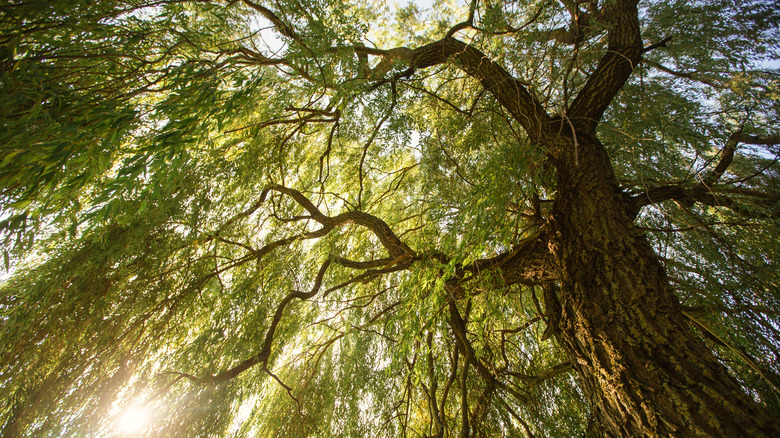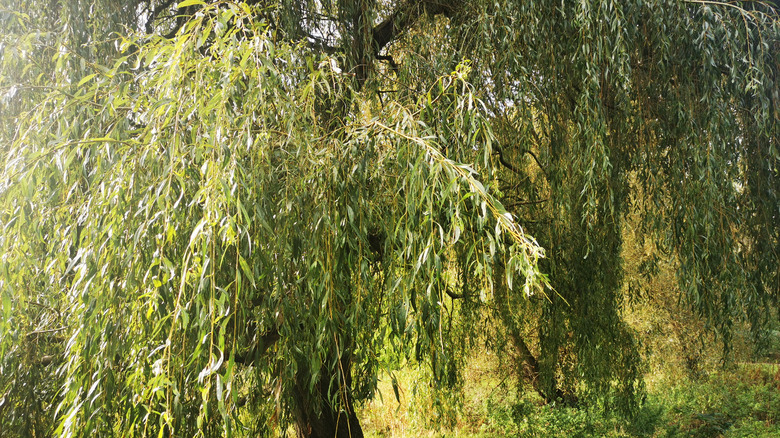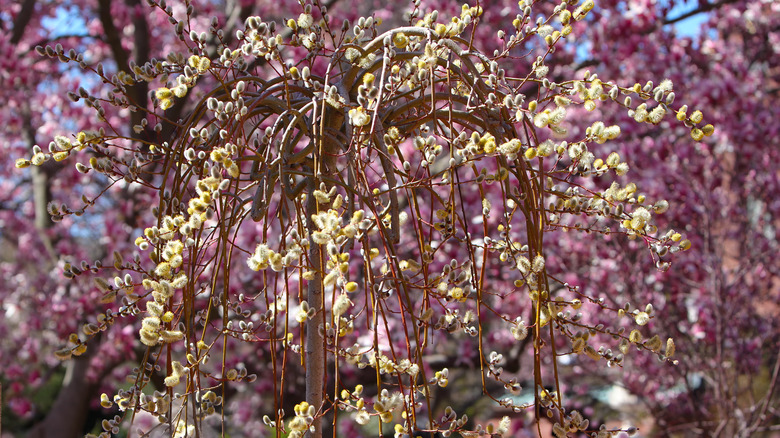How To Grow And Care For Weeping Willow Trees
The romantic weeping willow (salix babylonica) is loved worldwide for its dramatically arched branches and breathtaking presence. Native to China, weeping willows are a popular choice for many gardeners (via Gardening Know How). With heights reaching up to 50 feet or more, these trees are not just popular in gardens or parks, but have a solidified presence in history and culture. Love to Know lists the willow tree's presence in literature such as Shakespeare's "Othello," "Hamlet," and "The Twelfth Night," as well as "The Lord of the Rings" and "Harry Potter." Additionally, willow trees have also established roots in religious and ancient cultural texts, including biblical stories and ancient Greek and Celtic mythology. Furthermore, various Native American cultures view weeping willow trees as symbols of protection, and in ancient China they were revered as a symbol of immortality. Weeping willows were thought to be a symbol of mourning in Victorian art, too.
With its expansive cultural and historical reach, ethereal presence, and quick growing nature, the weeping willow is an excellent addition to your garden. Read on to learn how to grow and care for these majestic trees.
How to use weeping willow trees in garden
Weeping willow trees are sought after for their massive yet graceful presence. These large trees are an excellent way to add shade to your backyard or garden, creating a magical, cool environment for warmer months. TN Nursery also suggests planting weeping willows next to bodies of water, saying that the tree will grow quickly from the additional water, and add a majestic feel to your lake or pond. They also suggest planting weeping willows in areas of your yard that may experience water runoff, as the tree will absorb the excess water.
Weeping willow trees will also attract a variety of wildlife, such as rabbits, deer, and birds, according to This Old House. While this can make for an idyllic scene, make sure you don't plant the tree too close to gardens or crops that wandering creatures may be tempted to snack on. They also recommend planting the tree at least 50 feet away from your house so as to not block out natural light, as well as prevent deep roots from potentially causing foundational issues.
How to grow weeping willow trees
Growing weeping willow trees is quite an easy task due to their quick growing nature. The easiest way to grow a willow tree is to simply visit a nursery or garden center, purchase a young tree, and plant it in your yard. The only part of this process that may be difficult is choosing where to plant your tree — plant it far away enough from your house that a mature tree won't block the sun and so that its roots won't endanger the foundation of your home. Also be careful to avoid planting the tree near pipes or underground wires.
This Old House says to choose a spot that has anywhere from partial shade to full sunlight — but be aware that anything under a mature tree will be fully shaded. Your soil should be moist and well draining, as well as slightly acidic — this can be tested via a pH meter. Next, dig a hole two times the total width of the tree's root ball, add your tree, and fill with soil. Water thoroughly. Hunker suggests adding a 2 to 4 inch layer of mulch for moisture retention. This is not necessary if your tree is planted near a body of water. Consider adding a small mesh or wire fence around young trees to avoid it being eaten by wildlife (via Gardening Know How).
How to care for weeping willow trees
Caring for a weeping willow tree is an easy enough task due to the tree's tolerant nature. Weeping willow trees can handle partial shade to full sun, with The Spruce saying the tree prefers at least four hours of full sun a day. These trees love water, and are comfortable in standing water. Consider planting weeping willow trees next to bodies of water in areas of your yard that are prone to large puddles. It is a good idea to add gardening mulch on top of the soil surrounding your weeping willow tree to aid in moisture retention. The Spruce also suggests fertilizing weeping willows with a 20-20-20 fertilizer to ensure the tree will grow full and lush. Consider opting for ox manure for an organic choice.
According to Nature and Garden, you should prune weeping willows in early March to stimulate new growth. Using clean pruning shears, lightly cut back all the branches of the tree. Not only will this help the tree grow thicker and denser, but as it does so it will help prevent diseases.
Varieties of weeping willow trees
The willow tree family, or salix genus, has over 400 varieties, all coming in different sizes and colors (via Home Stratosphere). The willow genus is so expansive, there are even a couple varieties of weeping willow trees specifically. Here are a few willow varieties, both weeping and other.
-
Golden weeping willow (salix alba 'Tristis'): This weeping willow variety can grow to be up to 70 feet wide, according to SFGate, and as the name suggests, is distinct from the regular weeping willow for its golden leaves.
-
Wisconsin weeping willow (salix x blanda): This variety of weeping willow is remarkably similar to the original tree, but is smaller, only growing up to 30 feet tall.
-
Golden curls willow (salix matsudana): According to The Spruce, this willow variety used to actually be considered a weeping willow, and is unique for its curling, golden branches and leaves.
-
Pussy willow (salix discolor): This variety of willow is most attractive for its fuzzy, cone-shaped leaves, and is commonly used in floral arranging, says The Spruce.
-
Dappled willow (salix integra 'Hakuro-nishiki'): A smaller shrub variety, this willow is distinguished by its pink and white leaves.
Are weeping willow trees toxic?
Willow trees are not inherently toxic to humans. Their bark contains salicin, according to Healthline, which breaks down into salicylic acid and has a myriad of benefits. Willow bark has been used both historically and currently as an alternative to aspirin, and can aid in pain relief, weight loss, alleviating menstrual pains, and fever reduction, and is gentler on the digestive system and stomach. Willow bark can be consumed by chewing on the bark, soaking it in hot water for tea, or consumed in capsule, liquid, or topical form. Overconsumption of willow bark can lead to stomach ulcers, bleeding, or skin irritation, depending on how it's used, and is not recommended for people under 16 years old or those pregnant or breastfeeding.
Animals, however, should not consume weeping willows. The Nest warns that cats do not possess the enzymes necessary to break down the salicylic acid produced by the tree. Additionally, while the bark is not good for dogs, it's particularly toxic to younger dogs. Willow bark poisoning typically follows the same symptoms as aspirin exposure, and can happen over time. Look for loss of appetite, vomiting and diarrhea, signs of stomach ulcers, and lack of coordination or loss of consciousness. Immediately contact your vet if you think your pet may be experiencing willow bark poisoning. If you catch your animal eating willow bark, induce vomiting and then call the vet.
How to repot weeping willow trees
Weeping willow trees are not a common potted plant. Their impressive growth rate makes keeping a potted willow tree a relatively unsustainable endeavor. It is best to immediately plant a weeping willow tree kept in a nursery pot immediately in the ground.
If you want the look of a weeping willow without having to commit to its expansive, and sometimes invasive, growth, consider growing the weeping pussy willow. According to Gardening Know How, this smaller willow variety will only grow up to 30 feet, and is a great option to keep potted on a deck, patio, or garden.
These trees should be potted in large, heavy containers with equally large and heavy bases to hold up to their weight against weather. Repot the weeping pussy willow by potting it in a wooden or plastic pot in a soil mixture of one part compost to two parts soil-based compost. Water thoroughly and frequently, and ensure it gets full sun.
Common weeping willow tree pests and diseases
Weeping willows, while ethereal, are not invulnerable. Pests and diseases can affect the health and appearance of your tree if not properly addressed. According to The Spruce, weeping willow trees are vulnerable to pests such as aphids, borers, and gypsy moths. Hunker suggests spot treating infested areas with insecticide, pruning infected branches, and cleaning fallen branches and leaves from the base of your tree to prevent borers.
Common weeping willow tree infections can include root rot, cankers, fungi, willow scab, and willow blight. Willow scab is a fungus that manifests as green spores on the bottom of leaves, and can combine with other fungi to turn into willow blight. This can be treated by pruning the infected leaves and branches. Other diseases like powdery mildew and rust should not be a major cause for concern with healthy trees, and can usually be managed by pruning affected areas.
The weeping willow tree's biggest threat is crown gall. Crown gall is an infection that affects trees, and appears in tumor-like masses along the wood (via The Spruce). Willow trees are particularly vulnerable to this disease, as well as various fruit trees and roses. If you see crown gall on your weeping willow, remove and dispose of the tree immediately. When the soil has been exposed to crown gall, it is extremely hard to remove. Avoid planting anything where the tree was for a few years, and regularly check surrounding plants for signs of crown gall growth.







